
Sidwell Street photographs
Page added 23 October 2009
Sidwell Street, the ancestral home of the Grecians, has had a rich history. Never quite part of old Exeter, the street has been knocked about by histor, form the Prayer Book Rebellion of 1549 to the Civil War, when it was more or less raised to the ground during the seige of Exeter. Then, in the 20th Century, perhaps a half was destroyed by enemy action in 1942. These photos attempt to show how the street has changed over the last hundred years. if you have a photo, with or without an interesting story of Sidwell Street, contact me here.
Back
to Photo Essays
Also A history of Sidwell Street
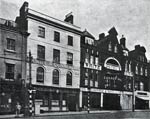 The
White Lion Hotel - 7 Sidwell Street
The
White Lion Hotel - 7 Sidwell Street
The White Lion Hotel was
one of Exeter's leading hotels at the end of the 19th Century. Roughly
situated where the new Sainsbury's is located, the building was lost in
the 1942 blitz. A sale notice from 1939 had the following on the
reverse in pencil – valuation for mortgage £14,250,
bar takings in 1938 – £3,236, food – £1,541,
apartments – £690. Photo courtesy Nick Baker.
 5 to 8 Sidwell Street
5 to 8 Sidwell Street
This
complete block was lost in the blitz. They were in 1902 –
5
Henry Avent, china dealer
6 Clark Plimsoll & Co, grocers
7
White Lion Hotel, James Lawless
8 Standfield & White, coach
builders. The photograph was taken after 1905 because the trams are
present.
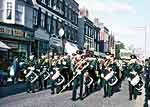 19 Sidwell Street
19 Sidwell Street
My notes state
this is a Rag Week Parade in 1967, although why there should be a
military band is a mystery. No 19 is Freeman Hardy and Willis, the shoe
shop. Ten years earlier there was a branch of Boots at no 20, and no 22
was Lipton's the grocer. Photo courtesy Alan H Mazonowicz.

 14 Sidwell Street
14 Sidwell Street
The
Era Hotel was a prominent hotel in the city from the 1880's until 1918,
when it closed, to be replaced by Freeth's Tofferies, who undoubtedly
benefited from a growing tourist trade for their Devon fudge.
Freeth's had
occupied 13A Sidwell Street before 1918.
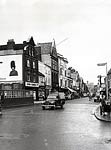 From 14
Sidwell Street looking east
From 14
Sidwell Street looking east
This
photograph shows the Era Hotel and Freeth's Tofferies building during
the
1950s. Every building from the corner of Sidwell and Longbrook Street,
up to John Farmer (no 14 - the first building in the photo) was lost in
the May
1942 blitz. All the
shops in this photo were demolished and replaced by Debenhams, and the
shops that ran up as far as Tesco, next to St Sidwells Church.
Surprisingly, in 1956, Freeth's
Tofferies still occupied the same building. Photo courtesy of the
Express & Echo.
 St Sidwells Church
St Sidwells Church
St Sidwells Church was rebuilt
in 1812-13, with the octagonal spired tower repaired in 1823. It
contained a clock and a peal of 10 bells. The earlier church had seen
some lively times, with Sir Walter Raleigh father imprisoned in it
during the prayer book rebellion of 1549. The church was very badly
damaged during the May 1942 bombing, and sappers were called in to
pull down the unsafe tower. The modern St Sidwells has found a role as
a hall for the community.
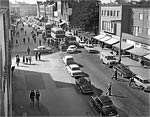 Looking
back down Sidwell Street in the mid 1960s
Looking
back down Sidwell Street in the mid 1960s
Time rolls forward to the early 1960s, when the shops between the
church and the corner of York Road had been rebuilt. The shops as far
as the church had not yet been demolished, and Debenhams was still in
the planning stage. Panters, the ladies clothing and household
store at No 32., can be seen in the photo, at the same store in which
they are found today. Charles Panter was trading at the same site,
although it was No 36., in 1897, making the store even older than
Thomas Moore. Photo courtesy of the City Parks Department.
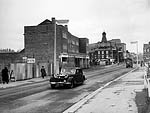 Half
constructed Sidwell Street
Half
constructed Sidwell Street
The new shops, which would contain
a branch of Woolworths,
in the photo to the left are still to be constructed in this photo from
the 1950s. Development tended to be short blocks, as and when finances
and materials became available. The St Sidwell Methodist Church and the roof of the Odeon behind that are
clearly visible. Even though most of Sidwell Street now consists of
post war development, only about half the buildings where lost in the
blitz.
 A
crowd waits for a tram
A
crowd waits for a tram
Standing in the centre of the
junction of York Road and Summerland Street, the photographer has
captured a crowd of children waiting for a tram. Notice the poles for
the tram wires are in the centre of the road, and arrangement that was
used on only three short sections of the system. The Sidwell Street
Methodist Church is left, and of course, it is still at least thirty
years before the Odeon was built.
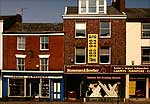
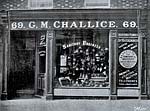 60 Sidwell Street
60 Sidwell Street
The
well known furniture store, Stoneman and Bowker occupies a building
that in 1956 was Tapper &co, house furnishers. But if you go back
to 1916, the building was the home of George Challice and Co, sanitary
engineers and electricians.
 Looking
back down Sidwell Street from Blackboy Road
Looking
back down Sidwell Street from Blackboy Road
The old Sidwell
Street split to become Blackboy Road and Old Tiverton Road. The Odeon
Cinema would now rear up, behind the tram, and the little girl would be
standing in the middle of the roundabout.
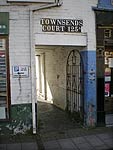 Townsends
Court next to Kirk Radio
Townsends
Court next to Kirk Radio
Before 1942, Sidwell Street
consisted of shops and offices on each side of the road, with small
alleys into a maize of courts lined with small, rat infested,
tenements, cheek by jowl with workshops. This entrance for Townsend
Court still exists next to Kirk Radio, right.
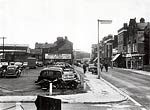 Motor
Macs and the bomb site
Motor
Macs and the bomb site
Another photograph taken from the
early 1950s, this shows the corner of Cheeke Street and Sidwell Street.
The bomb site up as far as Motor Macs is a car park – the site
was developed soon after to become the new home of the Express and Echo
and the Greyhound Hotel. Now,
of course, these two are now Somerfield and the Amber Rooms. Photo
courtesy of the Express and Echo.
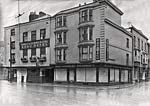 The Bude Hotel between Paris Street and
Southernhay
The Bude Hotel between Paris Street and
Southernhay
Before the war, the street to the right was the
outlet of the top of Southernhay, and the street to the left of the
Bude Hotel was Paris Street. Paris Street was realigned along the old
top of Southernhay, and the QS Fashion Store occupies this corner site.
│ Top of Page │